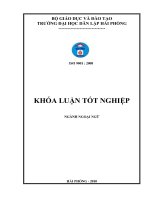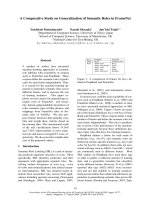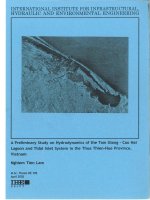A retrospective study on consequences of cesarean section in bovine
Bạn đang xem bản rút gọn của tài liệu. Xem và tải ngay bản đầy đủ của tài liệu tại đây (182.21 KB, 5 trang )
Int.J.Curr.Microbiol.App.Sci (2019) 8(1): 480-484
International Journal of Current Microbiology and Applied Sciences
ISSN: 2319-7706 Volume 8 Number 01 (2019)
Journal homepage:
Original Research Article
/>
A Retrospective Study on Consequences of Cesarean Section in Bovine
S.S. Dhindsa*, G.S. Dhaliwal, Harpreet Singh and S.P.S. Ghuman
Department of Veterinary Gynaecology and Obstetrics, Guru Angad Dev Veterinary and
Animal Sciences University, Ludhiana, Punjab, India- 141001
*Corresponding author
ABSTRACT
Keywords
Bovine, Cesarean
section, Dystocia,
Retrospective study
Article Info
Accepted:
07 December 2018
Available Online:
10 January 2019
The present study was conducted to analyze the consequences of cesarean section (csection) in terms of survivability and future fertility in bovine. The data from 304
veterinarians working at Civil Veterinary Hospitals, Punjab who performed 128 c-sections
(Cattle: 70, buffalo: 58) was collected through a specially designed questionnaire and
analyzed. A high overall survival rate was observed where indication of c-section was
pelvic fracture/abnormal pelvis (67.7 %) followed by incomplete cervical dilatation (66.7
%) and fetal monsters (63.6 %). The overall survival rate in cesarean operated animals was
65.6 per cent. About 18 per cent cesarean operated animals with < 12 h duration of
dystocia conceived, however, none of the animals conceived when dystocia was prolonged
for > 12 h. In conclusion, survival and future fertility rates in cesarean operated buffaloes
can be improved if time elapsed since occurrence of dystocia is less and a decision to
operate the animal is taken earlier.
Introduction
Bovine c-section is one of the oldest surgical
interventions in the field of veterinary science
and is a widely used emergency operative
technique for surgical delivery of calves in
dystocia affected bovine. For the veterinary
obstetrician, the development of the c-section
has great advantages like fetotomy on a living
calf can be avoided as well as other obstetrical
problems can be easily solved by the
operation. It is generally indicated when
obstetrical techniques have either failed or are
not applicable to deliver the fetus (Purohit et
al., 2012). The c-section dilemma has been
based on poor dam survival rates and poor
fertility, however many reports depicted that
dam survival is high when the operation is
performed early without previous handling
(Prabhakar et al., 2002).
In delayed cases, peritonitis may develop
following c-section due to leakage of uterine
fluids, rupture of suture material and knot
failure (Singh et al., 2002). Consequences of
peritonitis are uterine adhesions that
invariably lead to death or infertility (Dhindsa
et al., 2010). Post-operative intra-abdominal
adhesion formation is a potential problem
following c-section in bovine causing huge
480
Int.J.Curr.Microbiol.App.Sci (2019) 8(1): 480-484
economic loss to dairy farmers. Actually
bovine have an increased tendency to form
fibrous adhesions than other species as the
former have very low levels of plasminogen
activators and high levels of fibrinolytic
inhibitors, which favor the adhesion
formation. Therefore, bearing in mind csection as an important but complicated
surgery in bovine, a retrospective study was
conducted to analyze the consequences of
bovine c-section performed at the field level to
suggest prognostic indicators.
Materials and Methods
The present study was conducted by analyzing
the cesarean operations performed at the field
level by contacting 304 veterinarians of the
Punjab state. A total of 128 c-sections (Cattle:
70, buffalo: 58) performed by field
veterinarians, were analyzed. The information
regarding type, cause and duration of dystocia,
survivability, conception rate, any other postcesarean complication etc. was collected
through a specially designed questionnaire as
below in Table 1. The technique followed for
c-section was paramedian and ventrolateral in
right lateral recumbency under local
infiltration of anaesthesia. Statistical analysis
was done by using t test.
Results and Discussion
A retrospective study was conducted by
contacting 304 veterinarians of the Punjab
state. It was observed that most of the
veterinarians avoid performing c-sections
because of low survivability and fertility
following the surgery.
Out of the 304 veterinarians contacted, only
16 veterinarians had performed c-sections at
the field level. One veterinarian reported 52
operations, five reported between 7-16
operations and none of the other veterinarian
reported more than 3 operations. All the
veterinarians
performed
c-section
in
paramedian or oblique ventrolateral approach
in right lateral recumbent position under local
infiltration of anaesthesia using 60-80 ml of
Lignocaine hydrochloride 2 per cent solution.
The detail of indications for c-section and the
survivability following cesarean in dystocia
affected animals is given in Table 2. In cattle
and buffalo, maximum survivability after csection was seen in animals where indication
of operation was incomplete cervical
dilatation (76.0 and 64.7 %, respectively)
followed by pelvic fracture/abnormal pelvis
(70.0 and 63.6 %, respectively) and fetal
monsters (66.6 and 62.5 %, respectively). This
could be due to lesser degree of previous
handling or less damage to uterine wall in
these indications of c-section (Singh, 1996).
Moreover, pelvic fracture/abnormal pelvis are
easily diagnosed and hence there are fewer
chances of injudicious handling and c-section
could be done without any delay. The overall
survival rate in cesarean operated cattle and
buffalo observed in the present study was
higher (65.6 %) than that observed at the
teaching veterinary hospital, Guru Angad Dev
Veterinary and Animal Sciences University
(46.3 %; Dhindsa et al., 2010). This suggested
that the fresh cases might have had
encountered in the field at the time of surgery
while at referral institutes most of the dystocia
cases could be delayed. It is hypothesized that
stress of transport along with stress of dystocia
may further reduce the survival rate at referral
institutes.
Table 3 shows the survival and conception
rates of cesarean operated animals in relation to
duration of dystocia. In both cattle and buffalo,
the survival rate decreased with increase in
duration of occurrence of dystocia (83.3 to 39.0
and 66.7 to 41.7 %, respectively). C-sections
performed later than 36 h after onset of
dystocia lead to low survivability in dam owing
to endotoxaemic shock, haemorrhage, oedema
of the uterus and dehydration (Sloss, 1974 and
Saxena et al., 1989).
481
Int.J.Curr.Microbiol.App.Sci (2019) 8(1): 480-484
Table.1 Questionnaire used for collection of data from the veterinarians
1
2
3
Name and address of the veterinarian
Total number of cesareans performed
Indications for cesarean section
Fetal oversize
Monsters
Uterine torsion
Pelvic fracture/ abnormal pelvis
Incomplete cervical dilatation
Others
Number of animals previously handled
Cows
Buffaloes
4
Post operative complications
Complications
Infection at the operative site
Peri-uterine adhesions
Peritonitis
Others
Post cesarean section fertility
Fertility status
Number of animals conceived
Services/conception
Repeat breeding
Abortions
5
6
Total number of animals
Cows
Buffaloes
Number of animals survived/total
Cows
Buffaloes
Number of animals
Cows
Buffaloes
Cows
Buffaloes
Table.2 Survival rate in cesarean operated animals with reference to various indications for the
operation
Indications for
caesarean
Fetal oversize
Monster
Uterine torsion
Incomplete cervical
dilatation
Pelvic fracture/
abnormal pelvis
Overall
Cattle
13/20
(65.0)
2/3
(66.6)
1/2
(50.0)
19/25
(76.0)
14/20
(70.0)
49/70
(70.0)
Number of survived animals /total
(%)
Buffalo
9/18
(50.0)
5/8
(62.5)
5/10
(5.0)
9/17
(64.7)
7/11
(63.6)
35/58
(60.3)
482
Combined
21/38
(55.3)
7/11
(63.6)
6/12
(50.0)
28/42
(66.7)
21/31
(67.7)
84/128
(65.6)
Int.J.Curr.Microbiol.App.Sci (2019) 8(1): 480-484
Table.3 Survival and fertility rates in cesarean operated animals in relation to duration of
dystocia
Duration of
dystocia
A
(< 12 h)
B
(12-36 h)
C
(> 36 h)
Overall
Cattle
Buffalo
Combined
Survived/
Total
(%)
Conceived/
Survived
(%)
Survived/
Total
(%)
Conceived/
Survived
(%)
Survived/
Total
(%)
Conceived/
Survived
(%)
25/30
(83.3) **
15/20
(75.0) **
9/20
(39.0)
49/70
(70.0)
6/25
(24.0)
0/15
(0)
0/9
(0)
6/49
(12.2)
20/30
(66.7)
10/16
(62.5)
5/12
(41.7)
35/58
(60.3)
2/20
(10.0)
0/10
(0)
0/5
(0)
2/35
(5.7)
45/60
(75.0) *
25/36
(69.4)
14/32
(43.8)
84/128
(65.6)
8/45
(17.8)
0/25
(0)
0/14
(0)
8/84
(9.5)
* P<0.10, ** P<0.05; significantly different within column from group C (>36 h)
In the current analysis, about 18 per cent
cesarean operated animals conceived when
they were subjected to c-section within 12 h
of occurrence of dystocia, however none of
the animals conceived subsequently that
previously had c-section more than 12 h after
the occurrence of dystocia. This might be due
to higher tendency of formation of uterine
adhesions in delayed cases, thus, hindering
the involution of uterus. Previous studies have
also indicated higher plasma fibrinogen
concentrations, stress, tissue damage and
post-cesarean uterine adhesion formation in
prolonged cases of dystocia (Dhindsa et al.,
2009 and Dhindsa et al., 2010). The present
observations are also in concurrent with the
findings of previous report that total dam
survival rate for 73 c-sections performed by
practitioners in the field was 67.1 per cent
whereas for 102 operations performed at
referral centers; dam survival was only 43.2
per cent (Singh and Dhaliwal, 1998).
Similarly, Murthy et al., (1999) observed that
87 per cent of the cases survived when csection was done under institutional
conditions and 96 per cent survived under
field conditions and observed 100 per cent
maternal survival rate when c-section was
performed within 24 h of dystocia.
The current results suggested that the postcesarean survivability and future fertility may
be improved if surgery is performed within 12
h of onset of occurrence of dystocia, and
prompt and wise decision regarding c-section
as treatment to relieve dystocia is taken
without injudicious handling of the animal.
The current findings offer some guidelines for
the prognostic evaluation of dystocia affected
bovine for c-section.
References
Dhindsa, S.S., Dhaliwal, G.S., Sood N.K., and
Ghuman,
S.P.S.
2009.
Blood
biochemical
and
uterine
tissue
alterations in relation to duration of
dystocia in caesarean-operated bovines.
Indian J. Anim. Sci. 79 (1): 30-33.
Dhindsa, S.S., Dhaliwal, G.S., and Ghuman,
S.P.S. 2010. Factors influencing the
dam survival rate in bovines subjected
to caesarean section. Indian J. Anim.
Rep. 31: 49-51.
483
Int.J.Curr.Microbiol.App.Sci (2019) 8(1): 480-484
Murthy, K.K., Prasad, V., and Murthy, P.R.K.
1999. Clinical observations on uterine
torsion in
buffaloes. Indian Vet.
J. 76: 643-645.
Prabhakar, S., Nanda, A.S., and Ghuman,
S.P.S. 2002. Changes in plasma cortisol
concentrations as an index of stress
due to dystocia and obstetrical
manoevering in buffaloes. Indian J.
Anim. Sc. 72: 309-311.
Purohit, G.N., Kumar, P, Solanki, K.,
Shekher, C., and Yadav, S.P. 2012.
Perspectives of fetal dystocia in cattle
and buffalo. Vet. Sci. Dev. 2: 231-242.
Saxena, O.P., Varshney, A.C., Jadon, N.S.,
Sharma, V.K., and Dabas, Y.P.S. 1989.
Surgical management of dystocia in
bovine: A clinical study. Indian Vet. J.
65: 562-66.
Singh, J. 1996. Studies on the uterine
adhesions
following
caesarean
operation in buffaloes. M.V.Sc. thesis
submitted to Punjab Agricultural
University, Ludhiana, India.
Singh, J., and Dhaliwal, G.S. 1998. A
retrospective study on survivability and
fertility following caesarean section in
bovines. Indian J. Anim. Rep. 19: 2123.
Singh, J., Dhaliwal, G.S., and Jagir, S. 2002.
Efficacy of different treatments in
preventing uterine adhesions following
caesarean section to relieve dystocia in
buffaloes. Indian J. Anim. Sci. 72: 648651.
Sloss, V. 1974. A clinical study of dystocia in
cattle-I Treatment. Aust. Vet. J. 50:
290-93.
How to cite this article:
Dhindsa, S.S., G.S. Dhaliwal, Harpreet Singh and Ghuman, S.P.S. 2019. A Retrospective Study
on Consequences of Cesarean Section in Bovine Int.J.Curr.Microbiol.App.Sci. 8(01): 480-484.
doi: />
484









